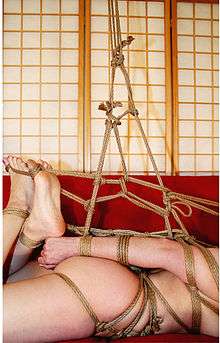Shrimp tie
A shrimp tie (海老責め ebi-zeme) (also known as an ebi (海老) or a kuri (繰り)) is a type of Kinbaku bondage. It originated over 300 years ago in Japan as a torture and interrogation technique. Due to the forced bent down position of the upper body this position sends a burning sensation through the body if the subject remains in it for a long time.[1]
Due to the knees which are widely spread the position resembles the legs of a crab or shrimp.
Variations

Reverse shrimp tie
- Knees are bound inward to further restrict movement
- The ankles are tied to the neck instead of the chest harness
- The subject lies on his or her belly and the ankles are drawn to the back, similar to hogtie bondage. This position is known as gyaku ebi, or reverse shrimp tie.
All variations have the crossed position of the ankles in common.
See also
References
External links
Youtube video on how to tie a shrimp tie, retrieved on 15 April, 2014
This article is issued from
Wikipedia.
The text is licensed under Creative Commons - Attribution - Sharealike.
Additional terms may apply for the media files.